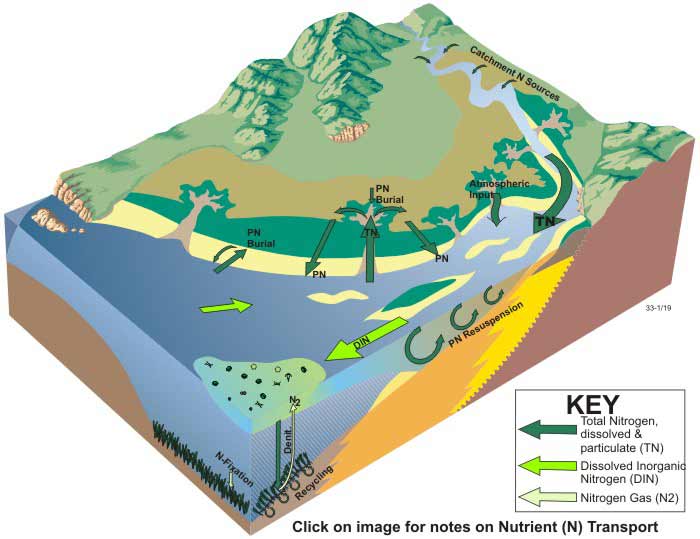
Nitrogen dynamic Processes in tide-dominated estuaries
1. Catchment freshwater input
Nitrogen, both particulate and dissolved or total nitrogen, enters the estuarine system from point- and non-point sources from within the catchment. River flow and nutrient input varies regionally, depending on local catchment and climatic conditions. However, the input of catchment-derived nutrients into estuaries and deltas is typically high (Harris, 2001).
2. Atmospheric sources
Input of particulate nitrogen from atmospheric sources such as smoke and ash is significant in some tide-dominated estuaries.
3. Tidal movements
Large tidal movements on the flanks of the estuary transport particulate nitrogen and dissolved inorganic nitrogen onto the sediments of the intertidal flats (Alongi et al., 1999), where some of the dissolved inorganic nitrogen is converted to particulate nitrogen through the activity of benthic micro-algae and other sediment-dwelling organisms.
4. Mangrove sediment
Mangrove sediment is a net sink for dissolved inorganic nitrogen and particulate nitrogen (Alongi, 1996). Nutrient uptake is driven by high rates of plant productivity and microbial activity. N-fixation (incorporation of atmospheric N2 to form nitrogenous organic compounds) is active in the root-zone and contributes to the dissolved inorganic nitrogen pool (Kristensen et al., 1998). Some nitrogen is liberated to the atmosphere as N2 gas through denitrification (Rivera-Monroy et al., 1996, Trott et al., 2000). Particulate nitrogen is typically processed by sediment-dwelling biota such as crabs, or is exported to the coastal waters in the form of leaf litter and fine particulate matter (Ayukai et al., 1998). This material is redistributed during ebb tides and may be exported from the estuary.
5. salt flat environments
Small amounts of particulate nitrogen are buried in salt flats during king tides. Most particulate nitrogen is exported back into the estuarine system during the ebb tide (Ridd et al., 1988).
6. Particulate nitrogen and dissolved inorganic nitrogen
Particulate nitrogen and dissolved inorganic nitrogen exist within the water column. However due to turbidity and low light penetration, phytoplankton productivity is limited (Cloern, 1987, Monbet, 1992). Circulation and re-suspension of particulate nitrogen occurs in this zone. Particulate nitrogen is probably reworked during the resuspension process, and dissolved inorganic nitrogen can be released into the water column through the process of remineralisation.
7. Tidal transport of dissolved inorganic nitrogen
A proportion of the dissolved inorganic nitrogen reaches the less turbid zone at the mouth of the estuary. The nitrogen exported into the ocean is typically assimilated by marine phytoplankton, and converted into particulate nitrogen.
8. Seagrasses
Seagrasses, which colonise the tidal sand banks near the mouth of the estuary, may also process nitrogen that has been exported from within the estuary. Denitrification may also occur here (Moriarty et al., 1993, Pollard et al., 1993).
9. Exchange of marine waters
Typically, moderate quantities of nitrogen are exported to the marine environment, due to the large exchange of seawater and lack of a constricted entrance. Export is more significant during extreme flood events, when large quantities of total nitrogen and other organic material are moved offshore.


